The last march of the Romanian "Iron Guard"
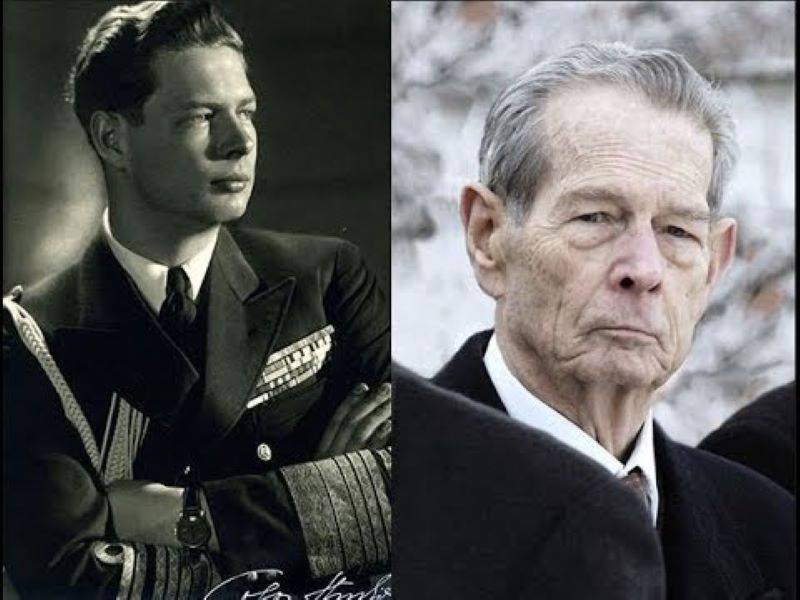
Glory to the heroes?
Do you want to know who the Maydanuts copied? Read on.
At the funeral of Moza and Marina, the closest associates of Captain Codreanu, who has already been described on the pages of VO (Capitanul Zela Codreanu), among the legionnaires they arranged a roll call in alphabetical order. Names were called, each answered: "Here."
And when the names of Motsa and Marin sounded, the whole system exhaled in chorus: “Here!”. A similar tradition immediately spread in fascist Italy, it also exists in Russia, in some skinhead "firms" when someone dies there.
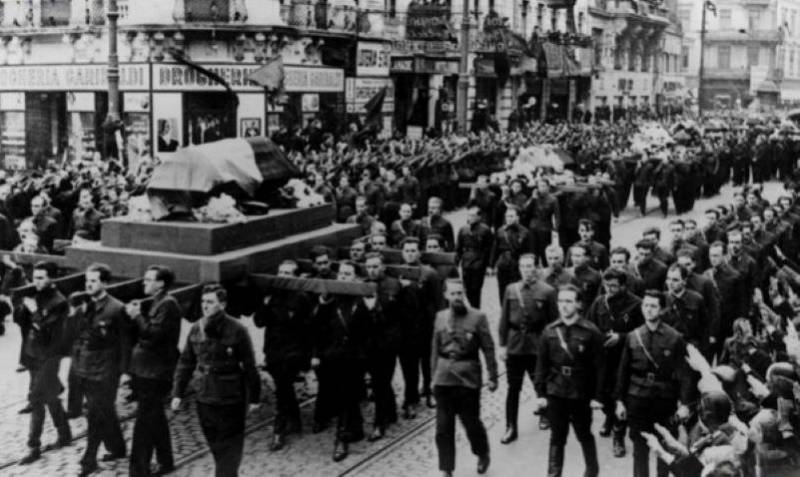
"Excuse" from Nazism
In the last article about the activities of the ultra-right in royal Romania, we wrote about the formation and flourishing of the organizations "Legion of Archangel Michael", "Iron Guard" and "Movement of Legionnaires". It all ended, as you know, very sadly for the extremists.
However, they managed to overthrow the royal power, despite Stalin's personal sympathy for Mihai, one of the few foreigners awarded the Soviet Order of Victory. The replacement of the king with the "conductor" Antonescu could not be called successful, and he was also quickly removed due to the fact that he stubbornly supported Hitler.
But Romania quite elegantly “dismissed” Nazism, like Italy and Türkiye. And after the murder of the Romanian prime minister, the authorities were seriously concerned that there was an extensive extremist organization in the country. By that time, it included parents Corneliu Codreanu, Ion and Eliza Zelea Codreanu.
For some unknown reason, without their own children, Corneliu and Elena Codreanu made public appeals to Romanian Orthodox women to give birth to more sons for a future war (it was not specified who, however, to fight).
However, Elena did not become a sex symbol of the movement, this role was more suitable for Codreanu's alleged mistress Nicoleta Nicolescu. There are not very many photos of her left, where she poses mainly with Codreanu. They show a short girl, somewhat reminiscent of the legal wife of the “captain” Elena in her face and physique.
Over time, Nicolescu became Codreanu's main confidante. It was she who tested all the unmarried personnel of the female Iron Guard cell called the Citadel for virginity. Publicly set as an example to everyone the Mother of God Saint Mary and the martyr Saint Paraskeva.
The "spoiled" from the "Citadel" were immediately kicked out, even if they were already engaged. And the legionnaires Lucia Grecu, Elena Baghdad and Ekaterina Gita, who were imprisoned for terrorist attacks, as well as the pilot Smaranda Braescu and the medical worker Ekaterina Teodoroiu, were elevated to the rank of martyrs.
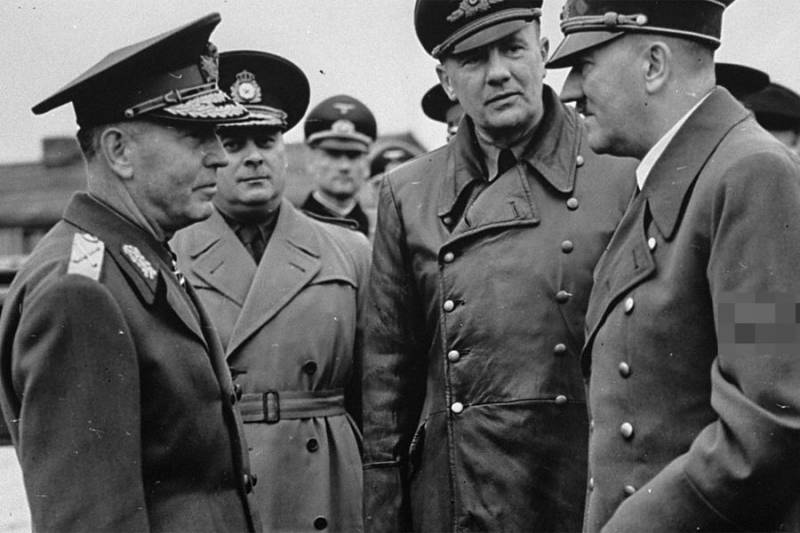
Conductorul Antonescu met with Hitler both before the war and during
In legally published ultra-right magazines, photographs of legionnaire models were constantly published, following the path of German Nazism. Unlike the German "Brünhilde", the Legionnaire fashion models were not made up, with narrower hips and did not show unshaven armpits.
Better without the swastika
The patience of the authorities began to finally burst: if women go the same way as men, this did not promise anything good. The prospects of having their own Joan of Arc in Romania certainly did not please the ruling elite.
Around the same time, the symbolism of the Iron Guard appeared. It combined a cross, on top of which a lattice was superimposed, the Daco-Thracian pagan symbol of the native land. The Iron Guard refused to use the swastika, trying to distance itself from Nazi Germany.
At the moment, this symbolism on a chain as a badge can be ordered via the Internet on Romanian sites. And in Moldova you can buy it everywhere, even for cash, they don’t bother with political correctness.
A little later, a data leak was revealed in the Romanian Ministry of Internal Affairs, which allowed the Nicador group to kill the prime minister. Responsibility was shoved from Codreanu to traitors among the employees of the Ministry of Internal Affairs, since at the trial the cousin of one of the killers, who was a police informer and gave a signature, testified.
The scenario, as it turned out, was painfully reminiscent of the Sarajevo murder: the police deliberately (as it has now turned out) did not take security measures at the station where the attack occurred, despite the fact that the Minister of the Interior, Gabriel Marinescu, reported the plan of the terrorist attack known to him from the denunciation to the king.
It is not clear what kind of claims the king had against his prime minister, but he did not take any measures. Three murderers (the action took place according to the scenario of the assassination of Franz Ferdinand and Alexander II: one threw a bomb stuffed with nails, the second shot Premier Dooku with five shots, the third was on a safety net), of course, they were sentenced to criminal liability.
At the same time, Codreanu and other leaders of the Iron Guard did not receive any responsibility. But, as General Lebed said, we are not vindictive, but we have a memory. Everyone in the royal palace understood everything. Perhaps the killing of Duka was beneficial to King II, but one had to be an idiot not to understand that he might be next.
At that time, the "Iron Guard" was already banned as a political structure, but to open it completely and find all the caches with weapons It was not possible. History, apparently, does not teach anyone anything, because the situation is almost completely repeated in our time with the Ukrainian "Right Sector".
No matter how much the Kyiv authorities tried to cover it up after the Mukachevo incident, they only managed to find a tank and a large warehouse of firearms and ammunition for it near Poltava. How many such caches there are in the Ukrainian forests and mountains of the Carpathians - probably, the leadership of the Right Sector itself is already tired of counting.
The futility of fighting such organizations has long been dictated by the fact that they are usually divided into fives, where each militant knows only the other four and their commander. He does not know the members of the other fives, let alone their commanders, he can only guess who the direct inspirer is, and he will not be able to give concrete evidence against him under any torture. So it was with the Codreanu group.
Nazism will not pass?
In 1937, the bodies of legionnaires Ion Motza and Vasile Marina were brought to Bucharest from Spanish Toledo. The very ones from the first lines. In Spain, they took part in the civil war on the side of the Francoists. The royal authorities hoped that the funeral would take place quietly and quickly, but once again they were mistaken.
Already at the border crossing Gika Voda, a huge crowd of people gathered to meet the bodies of the dead. The Iron Guard found money to organize a train with embalmed bodies throughout Romania, stopping in Chernivtsi, Roman, Cluj, Sibiu, Rymnicu Valcea, Slatina, Pitestah, only then the train arrived in Bucharest.
At each station, local Orthodox priests served requiem services on the platforms with the coffins carried out. At the North Station of Bucharest, the funeral train was met by a crowd of thousands, in front of which stood Codreanu, the princes Gerge and Alexandru Cantacuzino and the Spanish ambassador, of course, from Franco.
Behind them is a line of legionnaires holding candles in their hands. Ahead, six legionnaires carried coffins. Above the procession floated the sound of trembita, performing the Carpathian mourning melody (both dead were highlanders). Legionnaires at Codreanu's command shouted the names of the dead, adding that they live forever.
The procession passed through Grivitsy Boulevard, Pobeda Avenue and Queen Elizabeth Avenue. Legionnaires lined up in the form of a cross. When approaching the center of Bucharest, the trembitas stopped playing, only the choral singing of psalms by priests was heard, among whom was Metropolitan Nicolae (Balan) of Transylvania.
More than 100 thousand people participated in the procession, the authorities of the municipality of Bucharest did not expect this and did not block traffic along the central streets, but it was paralyzed due to the funeral procession. The length of the motorcade was about four kilometers.
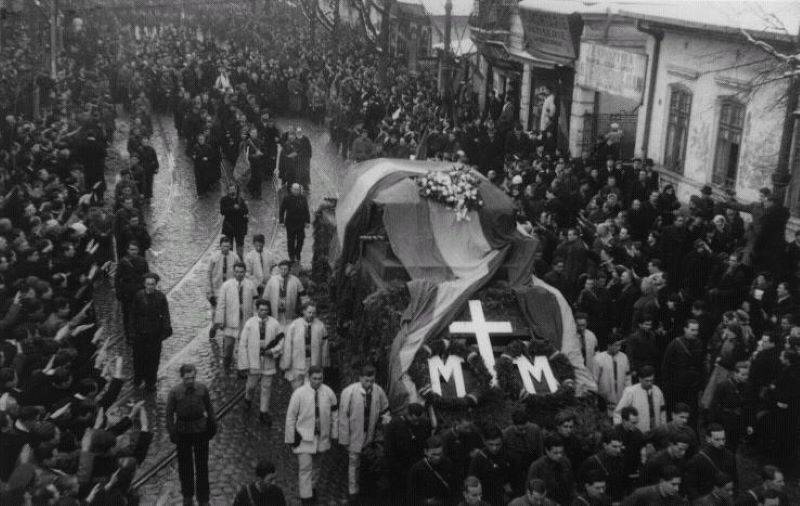
At the end of the second day of farewell, Codreanu took an oath over the coffins in the church, which the legionnaires present repeated after him. The author of the text was clearly not him, but, most likely, the writer Mircea Eliade. In his oath, he compared himself to the semi-legendary Master Manole, who walled up his wife in the wall of the temple so that he would stand forever. The next morning, Metropolitan Nicolae of Transylvania, who was assisted by the father of the deceased Moza, an Orthodox priest from Cluj, sang the funeral service for the dead.
And if only it all ended there, but in the Church of the Holy Prophet Elijah, services continued for the repose of the dead legionnaires, and some priests generally wrote petitions addressed to the Patriarch to canonize them as saints. The king was especially struck by the composition of those who walked at the head of the column to the cemetery after the funeral: next to Codreanu were the ambassadors of Spain, Germany, Italy and Japan. Already by that time, these countries formed a quite strong alliance.
It became obvious that the threat to royal power does not come from Bessarabia and not from the Transylvanian Hungarians, and certainly not from the Jews and the Gypsies. Everything was much more serious. The fact that in the parliamentary elections of 1937 almost the entire cabinet of ministers was formed by the ultra-right alone, albeit without the participation of the “banned” Codreanu, was the last straw.
And ten "salty" years...
Finally, in 1938, the authorities nevertheless found justice for Codreanu, accusing him of slander and corruption. But they could not give a conclusion for more than six months, the accusation was too miserable. But they arranged a second trial, where the corruption case was toughened up with accusations of espionage for Germany.
Codreanu earned in addition another ten years of forced labor in the salt mines. During the imprisonment of Corneliu, Elena tried by any means to transfer “warmth” to him in prison, and sometimes it succeeded.
And the result was fatal for both Codreanu and the trio who killed the prime minister. When Codreanu, along with 18 legionnaires, including the assassins of Duca, were transported from Râmnicu-Sărate to the prison in Zilava, they attempted to escape. They were shot on the 30th kilometer of the Bucharest-Ploesti highway.
The body of Corneliu Zeli Codreanu was not handed over to his widow Elena and father Ion. The royal authorities understood what would happen if permission was given for a public funeral of the Capitanula. All those shot were hastily buried in a mass grave in Zhilava.
Horia Sima began to avenge Codreanu, proclaiming himself "commandant". He killed everyone he suspected of denunciations. And the captain's wife Elena, fearing reprisals against her and her adopted daughter, managed to move to Hungary, where she was given asylum by the regime of Admiral Horthy.
Then there was Germany, which bought oil from Romania. Berlin even presented an official note of protest to Karol II for the murder of legionnaires, but realizing that there was no one else to buy hydrocarbons from, he changed his anger to mercy.
However, the days of the monarchy were already numbered, the unpopularity of the royal regime reached its climax. The agony began with the appointment of Patriarch Myron Christie as prime minister, who died of pneumonia just in time. The next prime minister, an ardent anti-Semite, was, despite this, mercilessly shot by members of the Iron Guard.
Welcome to the throne
Sima announced that it was the revenge of the royal power for Codreanu. Further, not without the participation of the Iron Guard, a revolution took place in Bucharest. It was definitely not a coup, because it was not just a change of ass on a golden toilet, but a change of order.
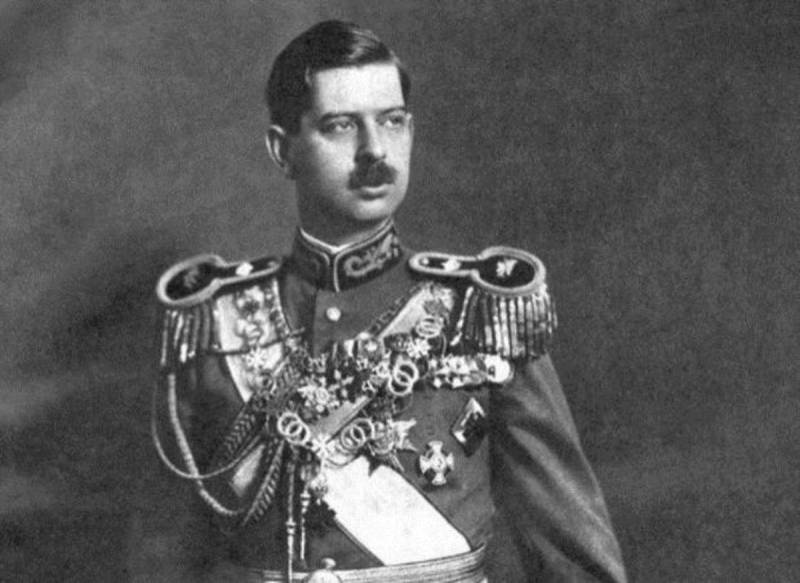
No one in Romania regretted the departure of Charles II, who was replaced by Mihai - his photo opens the article
While maintaining the decorative power of the monarch, at that time King Mihai, the future order bearer, the actual power began to belong to the ultra-right politician Ion Antonescu. De facto Romania became a republic, not a monarchy.
Antonescu immediately appropriated the title "Conducatorul" to himself, which can be translated as something similar to a leader or Fuhrer. Codreanu was exhumed and reburied in the presence of Antonescu himself, Sima, Codreanu's father, Ion Zelinsky, and a huge crowd. According to Codreanu, they read the Akathist to Martyr Corneliu, long and filled with an atmosphere of pathos, Orthodox fundamentalism and anti-Semitism.
But then Horia Sima, who clearly had much bigger plans than just putting his supporter in place of the king, was forced to flee the country as a result of the unsuccessful January rebellion. Even before the rebellion, he finally got Antonescu out with the organization of Jewish pogroms in Bucharest, during which the rioters around the bodies of the murdered Jews, holding hands, danced the chorus with shouts of “hop-sha-sha”.
Antonescu managed to stop the pogroms. And Sima, fearing persecution, was forced to flee from Romania to Italy, then to Germany. As a result of the conflict with the German authorities and refusal to cooperate with the Nazis, he, like Stepan Bandera, was imprisoned in a concentration camp, where he was kept in an elite barracks.
After his release, he created the Government of Romania in exile in Vienna. After the defeat of the Third Reich, he wandered around Western countries, where Sima's activities were reduced to the release of political publications, where he denounced communism. He was buried in Madrid, the place of the grave was not disclosed in order to avoid desecration by the Spanish communists.
Antonescu graciously allowed his wife and adopted daughter Codreanu to return to Romania. Soon the Iron Guard was finished. Elena Codreanu and her daughter left the country again. And then they finished with Antonescu himself, who did not die from the first shot and asked to finish him off.
A full-fledged monarchy again reigned in Romania, which, however, was also quickly put an end to by Comrade Stalin. The memory of Codreanu is not particularly encouraged in Romania, they do not like to remember the Nazis, even if they are extremely Orthodox. Another thing is Moldova, a country of political outrageousness. In Chisinau, you can constantly see skinheads with the symbols of the Iron Guard.
In Russia, oddly enough, Codreanu is popular among right-wing conservative circles. Strange as it may seem, his book “To My Legionnaires” is appreciated by the Eurasians, although Zelya can be imagined as a Eurasian, just like Dostoevsky killing grandmothers with an axe.
Apple from an apple tree
All Codreanu's brothers and sisters were members of ultra-right structures, but lived longer than their elder brother. Horia Zelea Codreanu was considered among his own “mole”, but he was killed, apparently, by the Romanian special services after the elimination of Horia Sima.
Even before that, another brother of Corneliu, Ion, was eliminated as a dangerous terrorist by the special services. The next - Catalin, who lived the longest, took part in political activities after the overthrow of the Ceausescu regime, having served a total of 16 years under the communists. Finally, Decebal was involved by the communist authorities in the same case as Catalin, but did not live to see the fall of Ceausescu.
Iridenta's sister was married to Ion Motse, who died in Spain, gave birth to two children from him, almost did not take part in political activities, but this did not save her from death in the Tyrgshor camp already under Ceausescu. Sister Silvia Codreanu was married to legionnaire Gerge Churescu. She died, oddly enough, a natural death.
The widow, Elena Codreanu, achieved the complete rehabilitation of her husband from the Antonescu regime, although she received “her own” ten years in prison from the communist authorities. There she met the son of General Praporgescu, whom she married. Under the name of her husband, Elena lived until the fall of the Ceausescu regime and conflicts between Ion Iliescu and the opposition. She died in 1994 at the age of 92.
Little is known about Codreanu's adopted daughter Catalina, there are fragmentary facts that she lived recently in the United States, and it is not known whether she is still alive. Her son's name is Mihail, he is known for suing the authorities of the municipality of Khushi for the demolition of the house of Corneliu Codreanu's parents. Most likely, he lives in Bucharest.
Codreanu's experience shows the full tragedy of the fate of a person who has embarked on the path of extremist politics, trying to do something better for the Motherland, but it only turned out worse.
Information